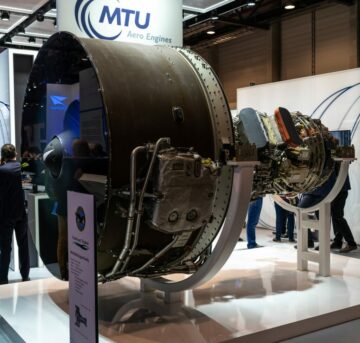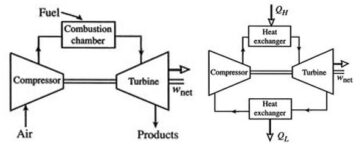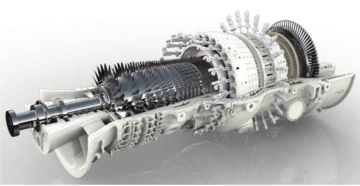As a special tribute this Veterans Day, we decided to have a look at some of the most notable engines that have been used to propel military vehicles throughout history.
PW F135
Kicking off our list is the Pratt & Whitney 135 turbofan engine. The pride and joy of Pratt & Whitney’s military engine lineup, the 135 powers the US Military’s F35 Lightning II. Presently, two variants of the F135 are used in several different variants of the F35, although it should be noted that the F135 was developed specifically for the F35. The 3 engine variants are known as the F135-PW-100, the F135-PW-600, and the F135-PW-400, each for a different application of the F35. The 100 variant is used in the conventional take off and landing F35A, the 600 is used in the F135B for short take off and vertical landing F35B, and the 400 uses salt corrosion-resistant materials for the Naval variant F35C.

The F135 is capable of 28,000 lbf of thrust with the afterburner capability pushing thrust all the way to a whopping 43,000 lbf of thrust, making the Lightning II a supersonic STOVL aircraft suited to a wide variety of applications, as seen in the above illustrations. At the heart of the Pratt F135 are 3 fan stages, 6 compressor stages, and 3 turbine stages. In the STOVL variant, the F135-600 uses the same core components, but is also coupled to a drive shaft which connects the engine to the lift fans which were originally developed by Rolls-Royce, and give the Lightning the ability to hover, perform short distance takeoffs, and vertical landings.

The F35 by Pratt & Whitney and in turn the F35 Lightning II by Lockheed Martin represent the cutting edge in military aviation, and are the centerpieces of Pratt and Lockheed respectively. The Lightning variants and this line of turbofan engines will be in service with several branches of the US military and its allies around the world for the foreseeable future, with more iterations of the F135 to come.

Honeywell AGT1500
For the next entry in our list, I thought that it might be interesting to go a slightly different route, and look at military armor – specifically the M1 Abrams main battle tank. The Abrams is the main tank of the US military since the 1980’s. One of its most distinct features, and the reason it is featured on this list, is that the engine used in the Abrams is not a conventional piston engine as is seen in most tanks. Instead, it uses a Honeywell (originally Lycoming) AGT 1500 gas turbine producing 1,500 shaft horsepower and nearly 4,000 lb-feet of torque

The Honeywell engine offers several advantages over conventional diesel engines often seen in modern military tanks – namely fuel diversity. As diesel may be hard to find at times, the Honeywell engine will reliably run on a wide range of fuels, including diesel, kerosene, gasoline, and jet-fuels like JP-8 or JP-4. This simplifies the logistics of providing fuel for the Abrams, which is necessary because the Honeywell turbine needs a lot of it. The other advantages of the turbine engine include high reliability, high speed capabilities (around 45mph on road surfaces, and 30mph on off-road terrain), and a different noise signature as opposed to diesel engines, making the Abrams quieter and harder to audibly detect at a distance.
There are however, some disadvantages that come with using a gas turbine in a tank. Namely, fuel consumption is a noted problem that the US military must cope with. The Honeywell turbine takes more than 10 gallons of fuel just to start, and burns 1.67 gallons per mile of travel, and can burn 10 gallons an hour at idle. Additionally, since turbine exhaust gas is extremely hot, troops are often unable to take cover close to the Abrams from behind, as is a common tactic when in combat and under fire. Lastly, as we have noted before, turbine maintenance can be more intensive than piston engine maintenance, making field repairs more challenging; however the Honeywell engine can be easily pulled and replaced with a new drop-in engine, as seen in this photograph.

As of now, it seems the M1 Abrams will remain in US military service for the foreseeable future, with the Honeywell AGT-1500 in service alongside it, earning it a spot on our notable military jet engines list.
The GE F110
For our next entry, we’re looking at General Electric’s GE F110 and its variant the F118. In the late 1970s the US Navy was having trouble with the main engines used in its newest multirole carrier-based fighter the F14 Tomcat (now famous for its prominent role in Top Gun and JAG). The engines procured from Pratt and Whitney were not able to provide the levels of thrust that the Tomcat would require as a fighter, and were prone to stalls in maneuvers that the Tomcat would be called upon to perform in air-to-air combat.

Enter the GE F110; it was an afterburning turbofan engine based on the already existing GE F101, which was General Electric’s first afterburning turbofan. Proving more than 23,000 pounds of thrust at sea level using the afterburner, a pair of these engines better suited the Grumman Tomcat for its mission profile and would go on to be installed in every subsequent Tomcat thereafter.

This isn’t the end of the F110’s story, however. The F110 found use in the General Dynamics F16 Fighting Falcon after the US Air Force looked for lower unit costs for the Fighting Falcon. The F110 now powers most of the F16 fleet, with the latest variants of the F110 delivering up to 32,000 pounds of thrust.

There’s one more notable application of the GE F110 family, and it’s found in rather stealthy applications with the US Air Force – namely the Northrop B2 Spirit and the Lockheed U2.

The General Electric F118 is the non-afterburning variant of the F110, and was developed specifically for use in the Northrop B2 Spirit flying wing stealth bomber. However, as the U-2 fleet had been around for decades and needed repowering to modern engines, the F118 was chosen and now powers several dozen U-2’s.

The GE F110 and F118 have both given new leases on life to a wide range of aircraft in military service, making them one of the most notable jet engines in military service.
The Pegasus Engine by Rolls-Royce
For our next entry, we’re looking to Rolls-Royce and the United Kingdom, specifically at the Rolls-Royce Pegasus engine and the famous aircraft it has powered. As far back as the 1950’s, aerospace and mechanical engineers were working to create airplanes that could utilize the thrust generated by a jet engine to take off, hover and land vertical as opposed to utilizing conventional runways for taking off and landing.
Bristol engine company spent the latter part of the 1950’s on various gas turbine designs which used numerous configurations of fans and multistage axial compressors paired to 1 or 2 turbine stages in order to create an engine that generated thrust without being too large or too heavy for use in an airframe.

By 1960 however, Bristol and Hawker had a prototype that was able to fly in tether and free hover, proving the concept of the vertical take off and landing aircraft that had eluded aerospace engineers for the better part of a decade. By the end, the Pegasus engine and the Harrier jump-jet were born.

The iteration of the Pegasus that was used in the Harrier and other vehicles was a two shaft design with 3 low pressure compressor stages, 8 high pressure stages, which were in turn driven by two low pressure and two high pressure turbines. Interestingly the low-pressure and high-pressure turbines counter rotate to prevent any gyroscopic effects.
Since the Harrier was the first plane to prove the concept, it was immensely popular with Britain’s NATO allies including the US military, specifically the US Marines.

Thanks to its ability to land in many places where conventional aircraft would be unable to land or take off from, the Harrier is able to provide close air support for US Marines, and has done so in every conflict since their first adoption by the US military.
One lesser known fact about the Pegasus engine, however, is that it almost found its way onto the Space Shuttle. When NASA engineers were creating the Shuttle, the original design called for an auxiliary power/propulsion unit for the Shuttle’s return flight through the atmosphere. This would have proven necessary if the Space Shuttle crew had to abort a landing and make another pass for the runway, and this variant of the Pegasus would have been used like a conventional jet engine, and not have ducting. Interestingly, it would have used liquid hydrogen fuel which would have been onboard the Shuttle already, and thus there wouldn’t be a need for a separate fuel tank for jet fuel. (Dow, Andrew)
Despite not going to outer space, the Pegasus opened the door for V/STOL aircraft, which has become an asset in NATO and continues to dictate military aviation R&D, considering the F35 Lightning II which we already discussed is also VTOL capable. The Pegasus continues to serve the US Marine Corps in the Harrier, and will be held in high regard by infantry, pilots, and engineers for decades to come.
The Power Jets W.1
If you’ve read some of our other blogs from earlier this year, this last entry shouldn’t surprise you. All modern military aviation owes a great debt to the pioneering undertaken by Sir Frank Whittle and his R&D team at Power Jets in the 1940’s.

Although Hans von Ohain was the first to get a jet to fly, Sir Frank’s achievements should not be overlooked simply for this reason. The Power Jets W.1 was based on a design called the Power Jets W U (Whittle Unit), which was the first turbojet to run. The W.1 was used in the Gloster E28/39, and it would go on to be the first jet engine built in the US, known as the General Electric I-A.

The design was a far cry from the modern turbofan engines of today like the Pratt & Whitney 135 or the General Electric GE9X engines. The W.1 was a turbojet that made use of a radial compressor stage, reverse flow combustors, and a single axial flow turbine stage. It only generated 850 pounds of thrust at 16,500 RPM. Sir Frank’s creation, however, proved the viability of the jet engine as a propulsion system for aircraft, as the RAF would see with the Gloster E28/39, and the US military saw with the Bell P59.

Although neither the Gloster nor the Bell were all that successful or used in widely used in military applications, these planes and their powerplants paved the way for aircraft that would be used widely, like the Gloster Meteor, the first jet powered fighter which was used by the Allies.

Although nowadays it is a given that jet engines are the optimal engine design for combat aircraft as opposed to piston driven propeller engines, this wasn’t the case back then, and Sir Frank fought a heavy uphill battle for the RAF and investors to see that a gas turbine engine could be used to power aircraft, as we covered a while back in a blog on his life and contributions to engineering. For that reason, The Power Jets W.1 and W.2 make this list of notable military jet engines.
Conclusion
There are certainly other engines that could have made this list, and perhaps this topic will need to be revisited in the future. However, in the meantime we at SoftInWay would like to extend our gratitude to those who have served in the armed forces; we cannot begin to understand the sacrifices made by those who serve, and can only offer our thanks for those who have heeded the call of duty.
Happy Veterans Day.
Source: https://blog.softinway.com/notable-military-jet-engines/
- Adoption
- Aerospace
- Air Force
- aircraft
- Airplanes
- Application
- applications
- around
- asset
- aviation
- Battle
- Bell
- blogs
- branches
- bristol
- call
- Call of Duty
- Common
- company
- conflict
- consumption
- continues
- Costs
- Creating
- day
- Debt
- delivering
- Design
- diesel
- distance
- Diversity
- dozen
- driven
- Edge
- Electric
- Engineers
- Facility
- falcon
- family
- featured
- Features
- Fire
- First
- FLEET
- flight
- flow
- Free
- Fuel
- future
- GAS
- ge
- General
- General Electric
- Giving
- gratitude
- great
- High
- history
- Honeywell
- HTTPS
- hydrogen
- Including
- Investors
- IT
- large
- latest
- Level
- lightning
- Line
- Liquid
- List
- logistics
- looked
- Making
- materials
- Military
- Mission
- namely
- Nasa
- Noise
- offer
- Offers
- order
- Other
- outer space
- Pilots
- Planes
- Popular
- pounds
- power
- pressure
- Production
- Profile
- R&D
- range
- research
- reverse
- Route
- Run
- SEA
- Sea level
- serving
- Short
- So
- South
- South carolina
- Space
- Spain
- speed
- Spot
- Stage
- start
- Storm
- successful
- support
- surprise
- system
- Testing
- Tether
- The Future
- travel
- turbine
- United
- United Kingdom
- us
- Vehicles
- Veterans
- W
- WHO
- Wing
- world
- year
- years







